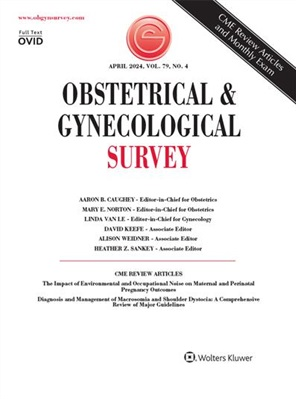Optimizing Surgical Wound Care in Obstetrics and Gynecology
IF 3.6
4区 医学
Q1 OBSTETRICS & GYNECOLOGY
引用次数: 0
Abstract
Importance Obstetrics and gynecology (OB/GYN) accounts for at least half of all open abdominal surgeries performed. Rates of surgical wound complications after open procedures in OB/GYN range from 5% to 35%. Therefore, optimizing management of surgical wound complications has the potential to significantly reduce cost and morbidity. However, guidelines addressing best practices for wound care in OB/GYN are limited. Objective The objectives of this review are to describe the fundamentals of wound healing and to evaluate available evidence addressing surgical wound care. Based on these data, we provide recommendations for management of extrafascial surgical wound dehiscence after OB/GYN procedures. Evidence Acquisition Literature search was performed in PubMed, Medline, OVID, and the Cochrane database. Relevant guidelines, systematic reviews, and original research articles investigating mechanisms of wound healing, types of wound closure, and management of surgical wound complications were reviewed. Results Surgical wound complications in OB/GYN are associated with significant cost and morbidity. One of the most common complications is extrafascial dehiscence, which may occur in the setting of hematomas, seromas, or infection. Management includes early debridement and treatment of any underlying infection until healthy granulation tissue is present. For wounds healing by secondary intention, advanced moisture retentive dressings reduce time to healing and are cost-effective when compared with conventional wet-to-dry gauze dressings. Negative pressure wound therapy can be applied to deeper wounds healing by secondary intention. Review of published evidence also supports the use of delayed reclosure to expedite wound healing for select patients. Conclusions Optimizing surgical wound care has the potential to reduce the cost and morbidity associated with surgical wound complications in OB/GYN. Advanced moisture retentive dressings should be considered for wounds healing by secondary intention. Data support delayed reclosure for select patients, although further studies are needed. Target Audience Obstetricians and gynecologists, family physicians. Learning Objectives After reading this article, the provider will be better able to explain the clinical significance of surgical wound complications, particularly in OB/GYN; identify the stages of wound healing and types of wound closure; discuss the TIME framework for wound care; and describe a recommended approach for the management of extrafascial wound dehiscence.优化外科伤口护理在妇产科
妇产科(OB/GYN)至少占所有腹部切开手术的一半。在妇产科开放式手术后,手术伤口并发症的发生率从5%到35%不等。因此,优化手术伤口并发症的管理有可能显著降低成本和发病率。然而,关于妇产科伤口护理最佳实践的指导方针是有限的。目的:本综述的目的是描述伤口愈合的基本原理,并评估外科伤口护理的现有证据。基于这些数据,我们提出了处理OB/GYN手术后筋膜外手术伤口裂开的建议。在PubMed、Medline、OVID和Cochrane数据库中进行文献检索。本文回顾了相关指南、系统综述和研究创面愈合机制、创面闭合类型和手术创面并发症处理的原创研究文章。结果妇产科手术伤口并发症与成本和发病率相关。最常见的并发症之一是筋膜外裂开,这可能发生在血肿、血清肿或感染的情况下。治疗包括早期清创和治疗任何潜在感染,直到出现健康的肉芽组织。对于伤口的二次愈合,先进的保湿敷料减少了愈合时间,与传统的干湿纱布敷料相比,具有成本效益。负压创面治疗可用于深层创面的二次创面愈合。对已发表的证据的回顾也支持使用延迟再闭合来加速选定患者的伤口愈合。结论优化外科伤口护理有可能降低产科/妇科手术伤口并发症的成本和发病率。对于二次创面愈合,应考虑采用高级保湿敷料。数据支持选择性患者的延迟重合闸,尽管需要进一步的研究。目标受众:妇产科医生、家庭医生。阅读本文后,医生将能够更好地解释手术伤口并发症的临床意义,特别是在妇产科;确定伤口愈合的阶段和伤口愈合的类型;讨论伤口护理的时间框架;并介绍一种治疗筋膜外伤口裂开的推荐方法。
本文章由计算机程序翻译,如有差异,请以英文原文为准。
求助全文
约1分钟内获得全文
求助全文
来源期刊
CiteScore
2.70
自引率
3.20%
发文量
245
审稿时长
>12 weeks
期刊介绍:
Each monthly issue of Obstetrical & Gynecological Survey presents summaries of the most timely and clinically relevant research being published worldwide. These concise, easy-to-read summaries provide expert insight into how to apply the latest research to patient care. The accompanying editorial commentary puts the studies into perspective and supplies authoritative guidance. The result is a valuable, time-saving resource for busy clinicians.

 求助内容:
求助内容: 应助结果提醒方式:
应助结果提醒方式:


